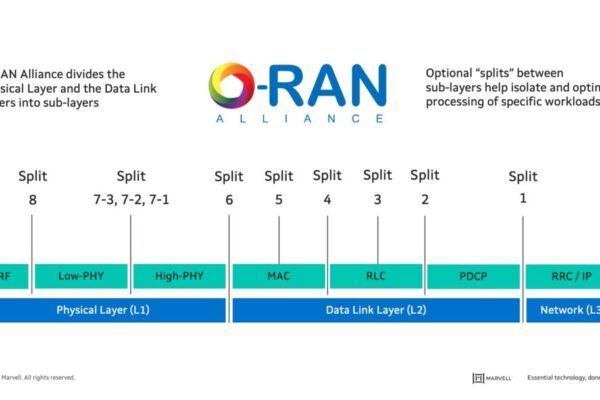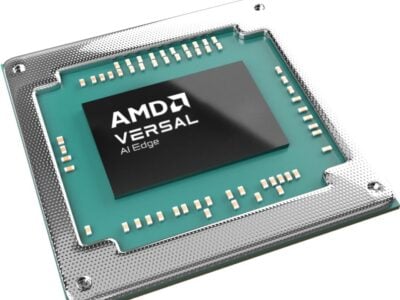
Open RAN is a key theme for Mobile World Congress this year, with several chip deals.
The O-RAN Alliance specifies various splits for different interfaces (shown above), with open 5G driving applications such as private networks, industrial IoT, VR and the metaverse and autonomous driving.
UK-Chinese chip designer Picocom has signed BLiNQ Networks in the US for a 5G Open RAN small cell distributed unit (DU) board. The agreement to buy silicon and license Picocom’s 5G NR PHY Layer software products will enable BLiNQ to accelerate the development of its upcoming small cells products.
The Picocom PC802 5G PHY SoC is optimised for disaggregated RAN small cells. It employs the FAPI protocol (defined by the Small Cell Forum) to communicate with and provide physical layer services to the MAC and has an integrated O-RAN Alliance Open Fronthaul interface, based on eCPRI, to connect and communicate with Open RAN (remote) radio units (RUs), as well as JESD204B interfaces to connect to radio transceivers.
“We are excited to be working with BLiNQ Networks – I’m proud to be able to announce publicly that our silicon and software will feature in future BLiNQ small cell products,” said Peter Claydon, President of Picocom. “This exciting news comes hot-on-the-heels of our PC802 PHY SoC market launch, and as we ramp up to its first public showing at MWC in Barcelona. PC802 is being designed into multiple products by several customers and will be in trials within the next few months.”
“Picocom’s SoC integrates well into BLiNQ Networks Private 5G Solutions, offering an ideal balance between traffic capacity and power consumption, and further simplifies component interfaces that other commercial solutions require,” said Radu Selea, CTO of BLiNQ Networks. “We are pleased to partner with Picocom and look forward to bringing our 5G NR O-RAN accelerator board to the market with the PC802 5G PHY SoC at its core.”
Meanwhile Indian operator STL has teamed up with Analog Devices for an Open RAN radio unit design. STL will integrate ADI’s RadioVerse transceivers into its Garuda O-RU indoor small cell radio unit and work with power amplifier (PA) vendors.
“STL has developed a set of open, disaggregated, virtualized and programmable products and solutions for the access side of the network,” said Chris Rice, CEO, Access Solutions Business, STL. “Garuda is a next-generation radio product with open interfaces compliant to O-RAN standards. It is cost-effective and a key component in solutions that deliver Industry 4.0 use cases, such as worker safety and factory automation. Leveraging Analog Devices’ RadioVerse offerings in our products creates a new industry benchmark for indoor small cell radios, enabling the full power of 5G technology to enhance billions of lives worldwide.”
As operators begin rolling out their Open RAN networks, there is increasing demand for regionally customized O-RUs to meet frequency band and power needs. The O-RU is one part of the network that cannot be virtualized, and with expanding requirements for the commercial-ready frequency band and power options, existing indoor radio options limit network operators’ choices. STL’s Garuda radio product line expands the availability of O-RU devices across global markets.
“Building on the success of the Garuda project, we look forward to expanding the collaboration with STL and providing the Open RAN ecosystem with high-performance O-RUs.” said Nitin Sharma, General Manager of the Wireless Systems Group at Analog Devices.
Marvell is also showing Open RAN designs using its latest Octeon Fusion ARM-based processor. The 5G Open RAN accelerator at the show integrates 5G in-line acceleration and ARM Neoverse processor cores for an Open RAN distributed unit (DU) reference design.
Open RAN is not just about vendor diversification and interoperability. With disaggregation and open interfaces, carriers also see the opportunity to evolve the 5G RAN to a more flexible architecture that optimizes bandwidth, power and cost for diverse network traffic conditions and advanced features, such as Massive MIMO. The O-RAN alliance specifies the “functional splits” across the Radio Unit, Distributed Unit and Central Unit that allow flexible partitioning of workloads across the network to reduce fronthaul bandwidth and promote multi-vendor interoperability.
Existing Open RAN alternatives rely on legacy compute architectures and implement the lower layer 5G protocols on the host server’s CPU cores. These general-purpose CPUs were designed for application-centric processing of use cases like web hosting, email, eCommerce and iPhone apps, but not for the kind of data-centric processing in the complex, latency-sensitive 5G Physical Layer (above)
The Octeon Fusion architecture integrates ARM Neoverse CPU cores and scales from small cells to high-capacity macro cells supporting traditional integrated and open, cloud RAN implementations. In the Radio Unit (RU), the family offers processing solutions for smart radio heads requiring more compute power to support the complex beamforming algorithms associated with massive MIMO antenna arrays.
www.picocom.com; www.analog.com; www.marvell.com
Related MWC articles
- Europe’s quantum tech on show at MWC
- UK looks to create sovereign Open RAN supply chain
- Vodafone, Samsung switch on first UK 5G Open RAN site
Other articles on eeNews Europe
- ALD centre of excellence to drive leading edge process technology
- Large woven display for the smart home and IoT
- First quantum network for blockchain
- Behind the new PICMG box PC standard
- Sequans, MicroEJ port edge container to cellular IoT chip
 If you enjoyed this article, you will like the following ones: don't miss them by subscribing to :
eeNews on Google News
If you enjoyed this article, you will like the following ones: don't miss them by subscribing to :
eeNews on Google News


